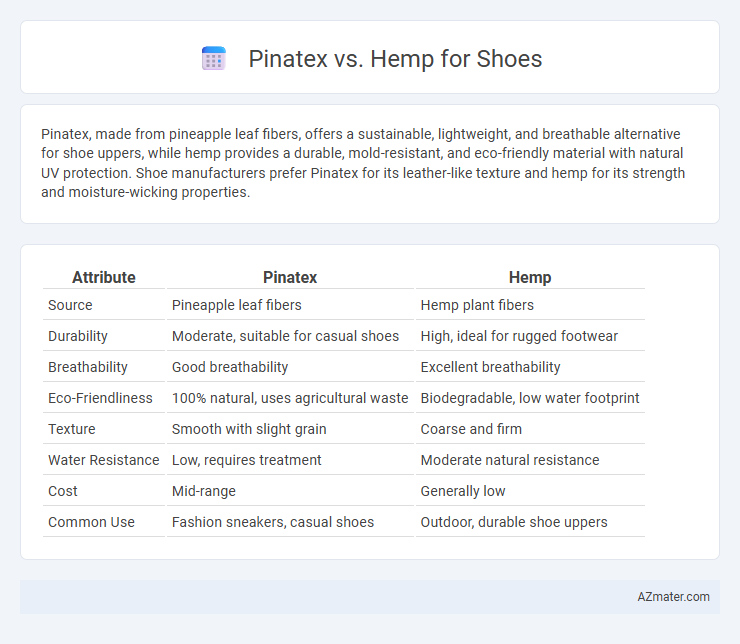Pinatex, made from pineapple leaf fibers, offers a sustainable, lightweight, and breathable alternative for shoe uppers, while hemp provides a durable, mold-resistant, and eco-friendly material with natural UV protection. Shoe manufacturers prefer Pinatex for its leather-like texture and hemp for its strength and moisture-wicking properties.
Table of Comparison
| Attribute | Pinatex | Hemp |
|---|---|---|
| Source | Pineapple leaf fibers | Hemp plant fibers |
| Durability | Moderate, suitable for casual shoes | High, ideal for rugged footwear |
| Breathability | Good breathability | Excellent breathability |
| Eco-Friendliness | 100% natural, uses agricultural waste | Biodegradable, low water footprint |
| Texture | Smooth with slight grain | Coarse and firm |
| Water Resistance | Low, requires treatment | Moderate natural resistance |
| Cost | Mid-range | Generally low |
| Common Use | Fashion sneakers, casual shoes | Outdoor, durable shoe uppers |
Introduction: The Rise of Sustainable Shoe Materials
Pinatex and hemp have emerged as transformative sustainable materials in the shoe industry, valued for their eco-friendly properties and durability. Pinatex, derived from pineapple leaf fibers, offers a vegan alternative to leather with a low environmental footprint. Hemp, known for its strength and natural resistance, provides biodegradable and breathable fabric options that reduce reliance on synthetic materials.
Piñatex: What Is It and How Is It Made?
Pinatex is an innovative sustainable material derived from pineapple leaf fibers, offering a strong, flexible alternative to traditional leather. The production process involves extracting fibers from pineapple leaves, which are then dried, beaten, and transformed into a non-woven mesh that mimics the texture and durability needed for shoe manufacturing. Compared to hemp, Pinatex provides a unique combination of eco-friendliness and aesthetic versatility, making it a popular choice for designers seeking plant-based, cruelty-free footwear options.
Hemp Fiber: Origins and Processing for Footwear
Hemp fiber, derived from the stalks of the Cannabis sativa plant, has been cultivated for centuries due to its durability and sustainability. The processing of hemp for footwear involves retting, decortication, and scutching to extract long, strong fibers ideal for shoe uppers and soles. Hemp's natural breathability, antimicrobial properties, and low environmental impact make it a prime choice compared to synthetic or less sustainable materials like Pinatex.
Environmental Impact: Piñatex vs Hemp
Pinatex, derived from pineapple leaf fibers, offers a sustainable alternative by utilizing agricultural waste, reducing landfill contributions, and requiring minimal water and pesticides compared to conventional leather. Hemp cultivation is known for its rapid growth, low water usage, and natural pest resistance, contributing to soil health and carbon sequestration during its growth cycle. Both materials present lower environmental footprints than traditional leather, with Pinatex focusing on waste valorization and hemp emphasizing regenerative agricultural benefits.
Durability and Performance Comparison
Pinatex, derived from pineapple leaf fibers, offers a lightweight and breathable option for eco-friendly shoes but tends to show moderate durability under heavy use compared to hemp. Hemp fibers are inherently strong and abrasion-resistant, providing superior performance in terms of longevity and wear resistance for footwear applications. When selecting materials for durable shoes, hemp generally outperforms Pinatex in maintaining structural integrity and durability over time.
Comfort and Breathability for Shoes
Pinatex, made from pineapple leaf fibers, offers a lightweight, flexible texture that enhances shoe comfort but may have moderate breathability compared to natural fabrics. Hemp provides superior breathability due to its open-weave structure and natural moisture-wicking properties, promoting foot ventilation and reducing odor. Both materials are durable and sustainable, yet hemp excels in airflow, while Pinatex delivers a softer, more adaptable fit for footwear.
Design Versatility and Aesthetic Appeal
Pinatex offers a unique texture and matte finish that enhances design versatility, allowing for intricate patterns and vibrant color treatments in footwear. Hemp stands out for its natural, earthy aesthetic and durability, making it ideal for casual and eco-friendly shoe designs with a rustic appeal. Both materials provide eco-conscious alternatives, but Pinatex often appeals to fashion-forward consumers seeking innovative, stylish options, while hemp attracts those valuing organic simplicity and ruggedness.
Cost and Market Availability
Pinatex, made from pineapple leaf fibers, generally costs more than hemp due to its novelty and sustainable branding, limiting its widespread market availability primarily to niche and eco-conscious shoe brands. Hemp offers a more affordable option with greater global cultivation, resulting in broader market access and more consistent supplies for mass shoe production. Both materials compete in the sustainable footwear sector, but hemp's established supply chain and lower cost provide a distinct advantage in scaling and price-sensitive markets.
Ethical and Social Considerations
Pinatex, made from pineapple leaf fibers, offers a sustainable alternative that supports small-scale farmers and reduces agricultural waste, promoting fair trade and community empowerment. Hemp, with its low water usage and rapid growth, provides an eco-friendly option that supports organic farming practices and strengthens rural economies through diverse crop cultivation. Both materials address ethical concerns by minimizing environmental impact and advancing social equity in the footwear industry.
Conclusion: Choosing Between Piñatex and Hemp for Sustainable Shoes
Pinatex offers a unique leather alternative made from pineapple leaf fibers, providing durability and a distinctive texture ideal for fashion-forward sustainable shoes. Hemp stands out with its superior breathability, strength, and biodegradability, making it suitable for eco-conscious consumers seeking long-lasting and environmentally friendly footwear. When choosing between Pinatex and Hemp, consider the desired aesthetic and performance qualities alongside environmental impact to select the best material for sustainable shoes.

Infographic: Piñatex vs Hemp for Shoe
 azmater.com
azmater.com